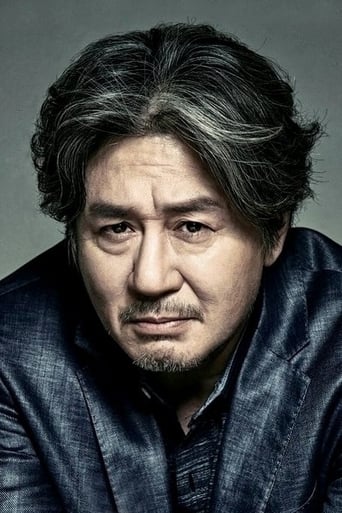SpuffyWeb
Sadly Over-hyped
Taha Avalos
The best films of this genre always show a path and provide a takeaway for being a better person.
Guillelmina
The film's masterful storytelling did its job. The message was clear. No need to overdo.
Bob
This is one of the best movies I’ve seen in a very long time. You have to go and see this on the big screen.
markbeardslee
It is not surprising that this film was made by I'm Kwon Taek at the time it was. He examined the early beauty and tragedy of Chosun Dynasty life in Seopyonje and delightfully explored a well-known Korean folk tale in Chunhyang, and these comprised his last two films. What is most surprising is that Chi Hwa Seon, his 2002 offering, is not presented in the pansori style of those previous two films.Nonetheless, the experienced hand of I'm comes through. We explore together the life of a real person: a late nineteenth century Chosun Dynasty painter who rides on the edge of modernity but who is not a noble and who, because of that, causes a stir in contemporary Korean society with his fame and his public and artistic expressions of disdain for the old Korean noble class and his contempt for would-be Japanese ruling colonials alike. The painter, Chang Seung Up, known popularly as Oh Won (performed magnificently by Choi Min Sik, the famous star of Park Chan Wook's already legendary "OldBoy") becomes more and more influential and therefore more dangerous throughout the film. Contemporary Korean audiences will back a hero like this despite the fact, or maybe because of the fact, that he was so ostracized in his time. I'm's sense of simultaneous beauty and tragedy in history remains intact. I'm is a master at capturing his country's past idiosyncrasies, and in this film he almost outdoes himself. As expected in an I'm film, the cinematography is breathtaking, the editing is precise and the story is central.Plots are set against Seung Up, family ties are tested and broken, scandalous behavior is alleged (and is sometimes real), all to bring down the man who "painted fire." But against all the intricacies of I'm's detailed but sometimes convoluted account of Seung Up's life, Seung Up himself somehow manages to survive. He becomes legendary because of his ability to perfectly copy famous Chinese paintings after only one look. Art dealers and agents then besiege him and try to make money off "Oh Won." In other words, lines of people, who wish to take advantage of the real Seung Up, an artistic star, begin to form. But he refuses to be manipulated. His cleverness in staving off both the massive hordes and the imperial lackeys impresses the audience, if not the cast. What does Seung Up think? He possesses powerful emotions and opinions about painting, such as the aesthetic belief that paintings are living things and are never truly finished. He despises those who would try to turn art into profit. And he cares not for politicians who use their might to bring artistic beauty around them and then cast off the artist as traitorous. But he also thinks that painting plays a role in the coming upheavals. Horrid scenes involving foreign invaders from France and Japan are presented. I'm's signature historical epic motif, and his influence in the realm, remains on prominent display in this multi-million dollar epic. The protagonist causes greater grief for himself and those who care for him when he refuses to paint. This is when the story takes on a whole new meaning, one that is not just political, but social in nature. I'm takes on the issues in laudable realist fashion. He, Oh Won, becomes a Jesus figure. The people believe him capable of artistic miracles and the government feels it needs his artistic support, but the protagonist remains fiercely independent and contemptuous of what others want him to do or be. Eventually, both government and people come down upon Seung Up in a manner taken straight out of the Bible. His holiness becomes human; his humanity is not accepted; he dies for (or escapes from) the sins of the commoners, the art critics, the politicians, who hound him. But does he die? As with most of I'm's films, a question remains. In this case, does Seung Up really become an immortal hermit? The film does not tackle that question; it merely presents a possible end for the real man of Chang Seung Up, or Oh Won. No death is depicted because no death is known. It is difficult to find fault with this film, but I'm has become so good at presenting various historical absurdities in his culture that when he does, it hardly surprises anymore. As usual for I'm's films, the cinematography, the editing and the writing are all first rate. It's a well-crafted film imbued with I'm's uncanny story-telling ability. Granted, he may be best at doing this through the ancient Korean musical art of pansori. Still, the film contains stretches of this admirable art form, and by the end, viewers feel as if they have become privy to a great, untold story. And they have, because that, precisely, is I'm's gift.
MartinHafer
Warning--this film has some amazingly graphic images and should never be seen by kids.The artist who this story is all about was indeed a fine Korean painter who rose up from the lowest depths to become their greatest painter. Unfortunately, in so many ways, this guy was also a jerk in so many ways. Some of this was the artistic temperament and what may have seemed annoying was just his demanding nature when it came to art. But, other times he was simply a drunk jerk--especially when he was on his way to becoming a great artist. Late in the film, his being annoying, abrasive and needlessly cruel seemed to have diminished. While all this didn't make him a particularly nice man, it is important to capture on film so we understand a lot about the nature of the artist.I really found the movie fascinating and loved how the artists actual works were shown throughout the movie (like in LUST FOR LIFE). I really wish I could show this to my students (I teach at a school for the arts), but can't because there is just too much adult material. Yes there is nudity, but even more problematic for any audience (particularly younger ones) is when he,....hmmm,...I don't think IMDb will even let me describe what occurred, but it was very graphic and involves bodily fluids. Not only a nasty and disgusting scene that did NOT need to be seen, but a reason to keep junior from watching this otherwise wonderful film. It's a real shame.
moribana
The fire gives all... This is one of film's most masterful meditations on artistry. Set in 19th century Korea it tells the story of the famous painter Ohwon, but rather than stick to saucy anecdote, melodrama, or psychological egg hunting, it portrays a series of episodes throughout his life, all of which are beautiful works of art in themselves. It gives no interpretation of these episodes, but leaves them for the viewer to ponder along with the paintings of Ohwon himself. In this way, the viewer enters into the same sort of contemplation as Ohwon, and minus his talent can "feel" their way into the inspiration of his paintings. Part of why this is so effective is the utterly masterful evocation of 19th century Korea and the musical/artistic world that Ohwon moved in. There are so many gorgeous shots of the world outside the paintings that we get a mirror effect where we see the beautiful world inspiring Ohwon, Ohwon living and looking in that world, and the works of art he creates, all mirroring off one another. The story is told with extreme economy. A feeling evoked is hardly ever lingered with or explained, it just appears quickly then is gone for the next one to appear. As an analogy it is a sort of Mozartian work of art (endless and quick succession of great ideas) rather than Beethovinian (Obsessive lingering on one great idea). It has a classical restraint, much like Ohwon's paintings. There is really no music hinting how to feel except a few classical Korean pieces used with great effectiveness in several scenes (and mostly played by characters in the movie). One haunting image, if I remember correctly, is of a flock of birds soaring away over the blue mountains while a female singer croons"This life is like a dream, and only death will awaken us" One telling line of advice in the film, from one of Ohwon's teachers, is that "the painting lies between the strokes." The film follows that attitude as there is so much matter *between* what is spoken and described in the film. I have seen it twice and it was very rewarding on the second viewing. A very terse film, with little in the way of obvert explanation, one could see how it is Im's 96th film. It is an artistic masterwork. Like Ohwon's great friend and mentor tells him in describing one of his paintings, "Not a single stroke is wasted." I compare it to Andrei Rubylev in quality, though in style it is very different. It is much easier and more directly entertaining to watch, but classical in form where Andrei is gothic. All in all highly recommended to almost anyone except appetite junkies. Both times I left the film I felt a wonderful spiritual renewal. One point of Ohwon's life that intruiged me was that his mad drinking and raving began suddenly after visiting the noble who told him that "Good art can come only from great knowledge and learning." The next brief scene Ohwon was very angry, and the next blasted drunk as he often remained for the remainder of the film. I am curious why the nobles words effected him so much and drove him to the drinking that dominated the rest of his life. Or was it just a coincidence?
Peegee-3
For one in love with nature and art, with both brought to the screen in breathtaking beauty, this movie offers the thrill of what great cinema is all about. This is the story of the development of a Korean artist in the 19th century, from his beggarly beginnings to great renown in his country. It's a very complex and often agonizing journey as this natural artistic genius struggles to create art for which he has enormous talent, but which is restricted by tradition and government control. The film spares us nothing...his heavy drinking, his sexual encounters, his rages...withal it's the underlyng "blessed unrest" of the artist that comes through. We're given the fruits of his creativity as well as awe-inspiring images of nature from which the work itself derives. This marriage of art and nature...man and his need to give expression to his talents is powerfully portrayed by the actors, the director...by all those responsible for this exquisite and uncompromising film,





